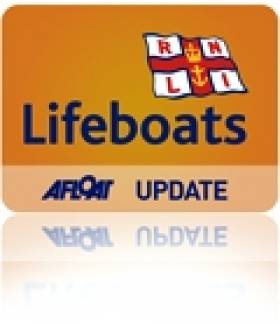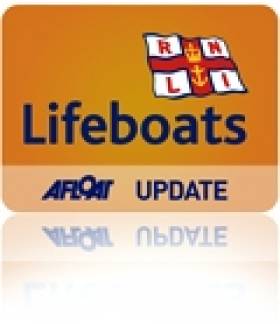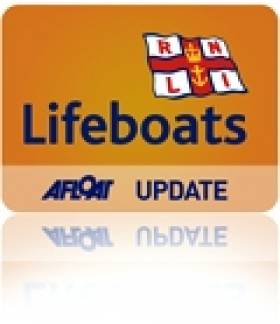Displaying items by tag: Portrush
Swim from Ballycastle to Rathlin Island Completed
Local French teacher Gary Knox has completed his swim from Rathlin to Ballycastle for Portrush Lifeboat Station on the very day that the station was celebrating its 150th Anniversary.
Gerry Doran Chairman of the Ballycastle Fundraising Branch texted the station at the start of the race and then at the end to confirm that Gary had completed his amazing feat!
This information was then relayed to the people who had gathered in Portrush for the Service of Thanksgiving and Vellum presentation.
Shelley Pinkerton, Chairman of the Portrush Fundraising Branch said
'This is an example of the innovative ways that people come up with to raise funds for the RNLI. It's very fitting that Gary completed the swim on the very day we are gathered to celebrate Portrush Lifeboat Station 150 years of saving lives at sea'
Gary who was not wearing wetsuit swam approximately 7 miles in 2 hours 55 minutes. The swim was for the RNLI and in memory of his friend and training partner, Ciaran McGinn who completed the endurance swim in 2007 and raised funds for his charity, Ballycastle RNLI.
Gary was accompanied by Portrush kayakers who followed the rib and provided him with energy drink every hour. In accordance with ILDSA rules, Gary was not permitted to touch the boat or kayak. Donations can still be made online at justgiving.com/gary-knox and there are collection boxes in the shops along the prom in Ballycastle.
Gary would like to thank Alan Wilson of Aquasports for providing boat cover, John Morton for advice and guidance, members of the Ballycastle Fundraising Branch and others for their assistance in organising the event.
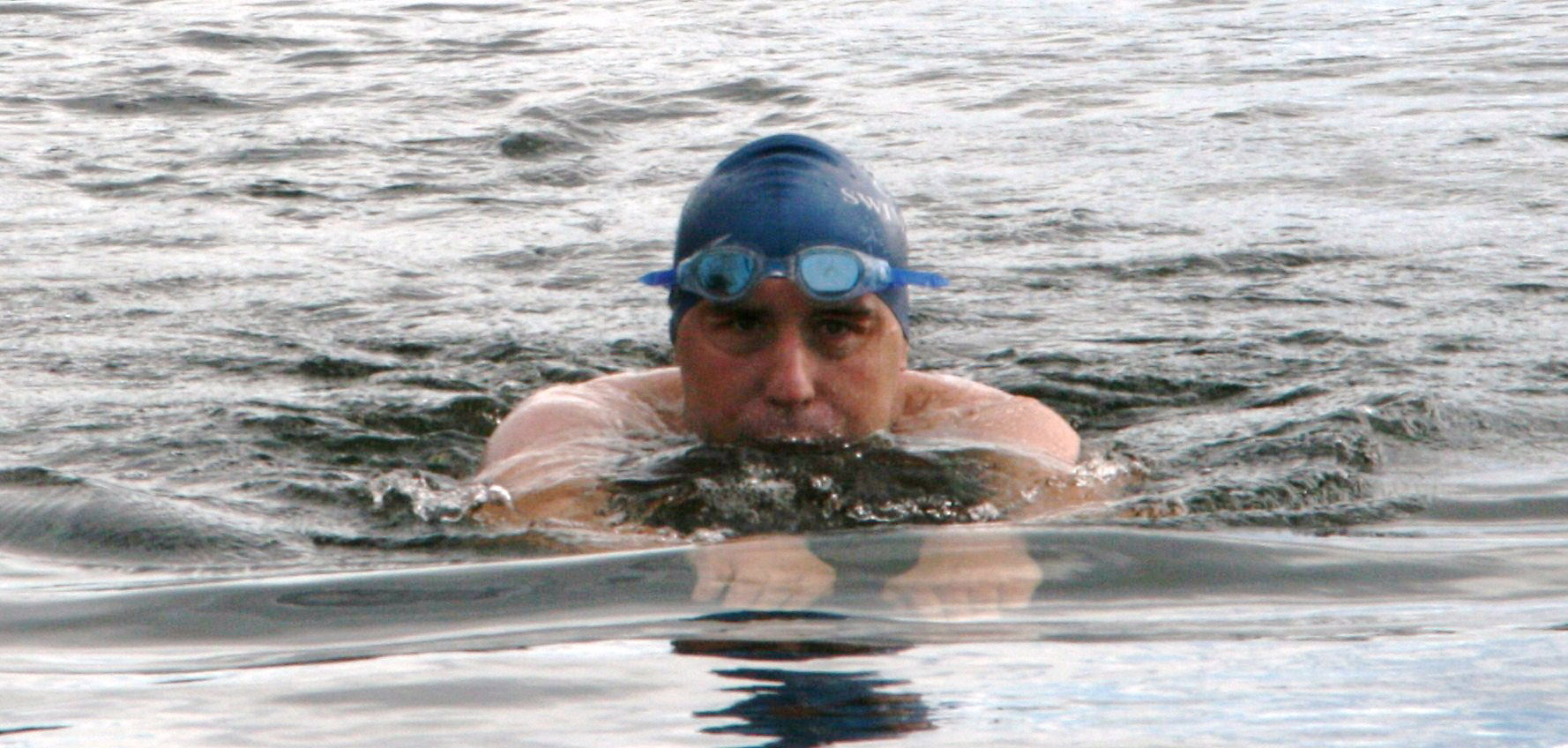
Gary nears the finish line
Portrush Lifeboat Station Celebrates 150 years
A service of thanksgiving marked the start of a year of events to celebrate Portrush Lifeboat Station's 150 years of saving lives at sea. The volunteer lifeboat crewmembers, fundraisers and supporters held a service in Portrush with the Inshore Boat 'The Ken and Mary' making her last appearance as a Portrush Lifeboat.
The event was held exactly 150 years after Laura, the Countess of Antrim helped establish the Lifeboat Station on the North Coast.
The service started with James Heaney, Chairman of Portrush Lifeboat Station giving a brief history of the station. Michael Hassan and Shay Reynolds sang a song that Michael had composed for the station called 'You're never on your own' and Ballywillan Band played the crews favourite hymns. By coincidence the band unveiled their new crest which includes a rope ring, a nod to their close relationship with the lifeboat station.
.
Father Sheehan, Reverend Simpson, Pastor Todd and Rev Kirkpatrick all did readings and prayers reflecting the dedication of the volunteer crews to saving lives at sea. Karl O'Neill one of the youngest crew members read the 'Lifeboat Prayer'
After the service John D Coyle MEconSc Chairman RNLI Ireland Council handed over a vellum to Robin Cardwell, Lifeboat Operations Manager. Mr Coyle praised the work of the crews and teams attached to the station and congratulated everyone on reaching this milestone. He reflected on the advances in technology which has made the lifeboats ever more sophisticated, but how the RNLI still depend on volunteers to crew them.
Robin accepted the vellum and thanked everyone for attending especially crew families who wait at home when the crews are out at sea. He thanked the crews for their dedication and commitment to training both on station and at Poole. He said that the vellum would be hung with pride at the station. Coxswain Willie McAuley presented Mr Coyle with a signed book on the history of the station and Shelley Pinkerton, Chairman of the Fundraising Team, proposed the vote of thanks to Mr Coyle, and reminded everyone why fundraising was so important to the RNLI.
After the formal proceedings ended Limavady Big Band sound played a medley of swing sounds which entertained everyone while friends past and present reminisced.
Related Safety posts
RNLI Lifeboats in Ireland
Safety News
Rescue News from RNLI Lifeboats in Ireland
Coast Guard News from Ireland
Water Safety News from Ireland
Marine Casualty Investigation Board News
Marine Warnings
New Lifeboat for Portrush
The volunteer RNLI lifeboat crew at Portrush have taken delivery of a brand new state of the art Inshore lifeboat and have wasted no time in putting the new lifeboat through its paces.
The new £30,000 lifeboat is named David Roulston (Civil Service No. 52) and replaces the previous lifeboat Ken and Mary D -572 which arrived on station in February 2002. The Ken and Mary was launched 151 times, saving 9 lives, landing 15 persons and bringing in a further 31 people, giving a total rescued of 55.
This new inshore lifeboat was funded by the Civil Service Lifeboat Fund which raised the funds for the lifeboat via staff fundraising within the civil service across the UK and Northern Ireland. Following the tragic drowning of their colleague David Roulston, the staff at Northern Ireland Tourist Board fundraised to cover the upkeep and maintenance of the new lifeboat which has been named in memory of David.
The new boat has a bigger engine 50hp as opposed to 40hp, better stowage and a GPS plotter. The boat is also much faster and thus will be quicker in terms of saving lives at sea around the North Coast.
Speaking about the arrival of the new boat Lifeboat, Operations Manager Robin Cardwell said,
"The crew are very impressed with the performance of their new lifeboat. They have already had intensive training sessions on the boat and are delighted to have it on station in Portrush. The new boat has arrived just as the Station is celebrating its 150th Anniversary and I have no doubt that 'David Roulston' (Civil Service 52) will play a big part in the station's future"
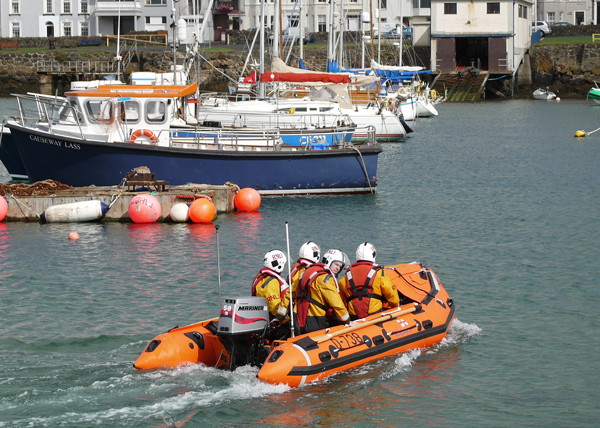
Related Safety posts
RNLI Lifeboats in Ireland
Safety News
Rescue News from RNLI Lifeboats in Ireland
Coast Guard News from Ireland
Water Safety News from Ireland
Marine Casualty Investigation Board News
Marine Warnings
Portrush Youngster Raises More Lifeboat Funds
Christy Bradley is Portrush Lifeboats youngest fundraiser and has carried out yet another fundraising event to pay for crew training!
Christy has a special reason to be interested in raising funds for crew training as his dad Gerard is a crew member and Christy's ambition is to be a crew member just like his Dad!
On Monday night Christy aged 9 came to a crew meeting and handed over £150 that he had raised by a 'name the bear' competition.
The bear had been given to Christy (9) by his Grandad Sid Carruthers and Christy decided that this would be the perfect way to raise funds for crew training.
Sandra Malcolmson was the lucky winner, and named the bear 'Bert'. She joined Christy and his dad Gerard crew member Aidy Tohill and Lifeboat Operations manager Robin Cardwell on Monday night to claim 'Bert'
Proud dad Gerard said,
'Christy has always been mad about lifeboats and is already planning his next fundraiser'
Robin Cardwell Lifeboat Operations Manager said
'It's great to see youngsters like Christy giving up their spare time and get involved in the Lifeboat fundraising initiatives. We are delighted that he supports crew training and look forward to his next venture'
Related Safety posts
RNLI Lifeboats in Ireland
Safety News
Rescue News from RNLI Lifeboats in Ireland
Coast Guard News from Ireland
Water Safety News from Ireland
Marine Casualty Investigation Board News
Marine Warnings



























